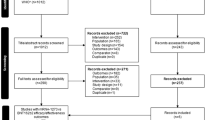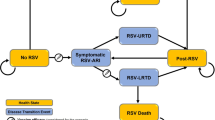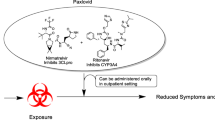Abstract
Objectives: We constructed a cost-effectiveness decision model to determine a hypothetical ‘best treatment’ pathway for patients presenting at our institution with influenza virus infection when the choice of treatment was either oseltamivir, zanamivir or a control therapy not active against influenza.
Methods: The decision model was constructed using DATA 3.5 for evaluating the cost-effectiveness analysis of neuraminidase inhibitors from the perspective of the healthcare payer. The time horizon was set at 14 days based on the general duration of influenza infection in Japan. Clinical outcomes were mainly derived from reports and guidance published by the National Institute for Clinical Excellence in the UK. Japan-specific cost parameters incorporated into the decision model were taken from the Medical Fee Point Survey conducted at St Luke’s International Hospital in accordance with medical fee receipts kept at our institution. The study included four professionals and a supporter who gathered information required for the analysis.
Results: In otherwise healthy adults, cost savings of ¥831.6 (approximately $US6.72; 2002 values) in the oseltamivir group and an increment in cost of ¥40.5 (approximately $US0.33) in the zanamivir group were achieved in comparison with the control group. In contrast, an incremental cost of ¥288.4 (approximately $US2.33) was incurred in the oseltamivir group versus the control group when at-risk patients were assessed, but cost savings of ¥159.8 (approximately $US1.29) were achieved in the zanamivir group. As a result of cost-effectiveness and cost-utility analyses in otherwise healthy adults, oseltamivir dominated the control therapy because cost savings in the oseltamivir group were made. In the zanamivir group the cost was incremental and the Incremental Cost-Utility Ratio (ICUR) compared with the control group was about ¥13 000 (approximately $US107.34)/quality-adjusted life-year (QALY) gained. As a result of cost-effectiveness and cost-utility analyses in at-risk patients, in the oseltamivir group the cost was incremental and the ICUR compared with the control group was about ¥230 000 (approximately $US2138.77)/QALY gained. As cost savings were made, zanamivir dominated the control therapy.
Conclusion: While the cost effectiveness (from the perspective of a healthcare payer) of the neuraminidase inhibitors was superior to that of the control group in the treatment of otherwise healthy adults with influenza in our study, it seemed necessary to take other factors into consideration before recommending one agent over the other as a first-line therapy. On the other hand, we suggest that zanamivir is the drug of choice for use in at-risk patients, and we recommend, in the light of our results, that if zanamivir is not available another therapy should be given rather than oseltamivir. Since with influenza infections deaths and hospitalisations of at-risk patients impact on the Japanese community, decision-making on the appropriate therapy should take into account the particular patient group involved.








Similar content being viewed by others
References
Matsuda S. A report of a Bureau of the Ministry of Health and Welfare: the research for utilisation of classification of diagnosis based on diagnosis procedure combination (DPC) for hospitalisation in acute period [online; in Japanese]. Ministry of Health, Labour and Welfare, 2002. Available from URL: http://www.webabst.niph.go.jp
Tachibana T, Kawaminami K, Minowa M. Excess mortality from influenza epidemics in Japan, 1980–1994 [in Japanese]. Nippon Koshu Eisei Zasshi 1999; 46: 263–74
Kasai T, Togashi T, Morishima T. Encepholopathy associated with influenza epidemics. Lancet 2000; 355: 1558–9
Fedson DS, Hirota Y, Shin HK, et al. Influenza vaccination in 22 developed countries: an update to 1995. Vaccine 1997; 15: 1506–11
Yamakoshi M, Suzuki K, Nakakita T, et al. Respiratory viral infections in the elderly in a nursing home [in Japanese]. Kansenshogaku Zasshi 1998; 72: 876–82
Matsumoto K, Shimokata K, Yamamoto M, et al. Economic impact of zanamivir on the treatment of influenza infection in Japan [in Japanese]. Kagaku Ryoho no Ryoiki 2002; 18: 99–109
Watanabe A, Kobayashi M. Socioeconomic analysis of oseltamivir for influenza patients [in Japanese]. Nippon Kagaku Ryoho Gakkai Zasshi 2001; 49: 95–102
Turner D, Wailoo A, Nicholson K, et al. Systematic review and economic decision modelling for the prevention and treatment of influenza A and B. Health Technol Assess 2003; 7(35): iii–iv, xi–xiii, 1–170
Drummond M, Pang F. Transferability of economic evaluation results. In: Drummond M, McGuire A, editors. Economic evaluation in health care: merging theory with practice. New York: Oxford University Press, 2001: 257
ISPOR Lexicon. In: Pashos CL, EG Klein, LA Wanke, editors. Princeton: International Society for Pharmacoeconomics and Outcomes Research, 1998
Kashiwado S, Kudo S, Watanabe A, et al. Clinical efficacy and safety of the selective oral neuraminidase inhibitor oseltamivir in treating acute influenza: placebo-controlled double-blind multicenter phase trial [in Japanese]. Kansenshogaku Zasshi 2000; 74: 1044–61
Matsumoto K, Ogawa N, Suzuki H, et al. Efficacy and safety of zanamivir (GG167) in the treatment of uncomplicated influenza virus infection — late phase [in Japanese]. Kagaku Ryoho no Ryoiki 2000; 16: 3–22
Hara Y, Nobutomo K. Influenza infection and health economics [in Japanese]. Influenza 2001; 2: 29–35
Burls A, Clark W, Stewart T, et al. Zanamivir for the treatment of influenza in adults: a systematic review and economic evaluation. Health Technol Assess 2002; 6(9): 1–99
Kaji M, Koike R, Sakai H, et al. Bureau of the Ministry of Health and Welfare report: the committee on the management of flu pandemic caused by a new type of virus [online; in Japanese]. Ministry of Health, Labour and Welfare, 1997. Available from URL: http://wwwl.mhlw.go.jp/shingi/slO24-3.html
Kaji M, Kaji Jr M. Clinical picture of influenza in the elderly [in Japanese]. Rinsho To Uirusu 1999; 27: 406–12
Aoki FY, Fleming DM, Griffin AD, et al. Impact of zanamivir treatment on productivity, health status and healthcare resource use in patients with influenza. Pharmacoeconomics 2000; 17(2): 187–95
Drummond MF. Health economic models: a question of balance — summary of an open discussion on the pharmacoeconomic evaluation of non-steroid anti-inflammatory drugs. Rheumatology (Oxford) 2000; 39 Suppl. 2: 29–32
Drummond MF. The use of health economic information by reimbursement authorities. Rheumatology (Oxford) 2003; 42 Suppl. 3: 60–3
Tsuchiya A, Ikeda S, Ikegami N, et al. Estimating an EQ-5D population value set: the case of Japan. Health Econ 2002; 11: 341–53
The patient survey for 2002 published by the Statistics Bureau of the Ministry of Health, Labour, and Welfare [online; in Japanese]. Available from URL: http://wwwdbtk.mhlw.go.jp/
The Infectious Disease Surveillance reported by the Infectious Disease Surveillance Centre of the Ministry of Health, Labour, and Welfare. Welfare [online; in Japanese]. Available from URL: http://wwwdbtk.mhlw.go.jp/
The Japanese Respiratory Society guidelines for the management of community-acquired pneumonia in adults. Revised 2002. Welfare [online; in Japanese]. Available from URL: http://www.jrs.or.jp/quicklink/glsm/index.html
Collection and analysis of data. In: Drummond MF, O’Brien BJ, Stoddart GL, {etet al}., editors. Methods for the economic evaluation of health care programmes. 2nd ed. New York: Oxford University Press, 1997: 251
Laupacis A, Feeny D, Detsky AS, et al. How attractive does a new technology have to be to warrant adoption and utilization? Tentative guidelines for using clinical and economic evaluations. CMAJ 1992; 146(4): 473–81
Acknowledgements
The authors thank Prof. Makoto Shiragami and his staff at the Department of Social and Administrative Pharmacy Science, College of Pharmacy, Nihon University, Japan, for their cooperation in gathering information.
GlaxoSmithKline Japan provided information on published NICE reports, but provided no financial support for this study. The authors have provided no information on conflicts of interest directly relevant to the content of this study.
Author information
Authors and Affiliations
Corresponding author
Rights and permissions
About this article
Cite this article
Inoue, T., Watanabe, K., Chonabayashi, N. et al. Pharmacoeconomics of Antiviral Therapy for Influenza in a Japanese Hospital Setting. Clin. Drug Investig. 25, 49–63 (2005). https://doi.org/10.2165/00044011-200525010-00005
Published:
Issue Date:
DOI: https://doi.org/10.2165/00044011-200525010-00005




